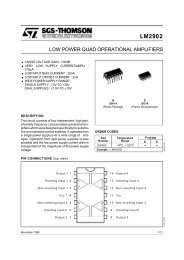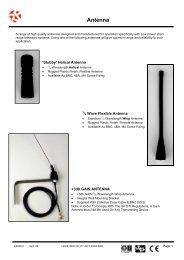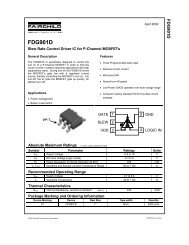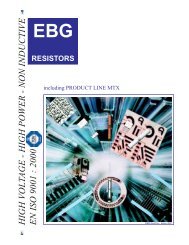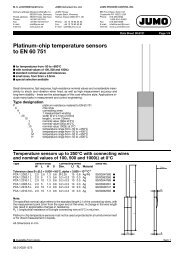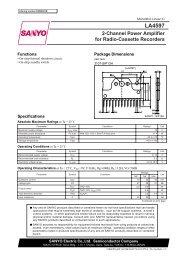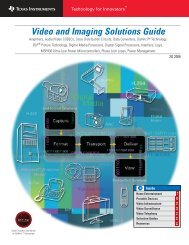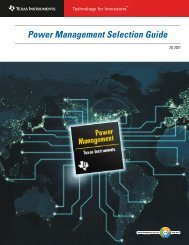Amplifier and Data Converter Selection Guide
Amplifier and Data Converter Selection Guide
Amplifier and Data Converter Selection Guide
- No tags were found...
Create successful ePaper yourself
Turn your PDF publications into a flip-book with our unique Google optimized e-Paper software.
36<br />
➔<br />
<strong>Amplifier</strong>s<br />
Audio <strong>Amplifier</strong>s<br />
Consumers are enjoying new ways to<br />
listen to music, books <strong>and</strong> news, while<br />
dem<strong>and</strong>ing more flexibility, better quality <strong>and</strong><br />
multifunctional products. There is an<br />
ever-increasing dem<strong>and</strong> for high-end<br />
entertainment for the everyday consumer.<br />
The market expects the best listening<br />
experience from any audio format <strong>and</strong><br />
source, mobile or stationary <strong>and</strong> at a<br />
competitive price.<br />
TI’s New Audio Quick Search Tools!<br />
On TI’s Audio Home Page, we have added a great new feature! Our Audio Quick Search<br />
Tool allows you to easily find the Audio device based on your design specifications. It’s<br />
easy to use, just go to www.ti.com/audio <strong>and</strong> select one of the available tools, such as<br />
Audio <strong>Amplifier</strong>s, <strong>Converter</strong>s or CODECs. Select your options <strong>and</strong> the suggested device<br />
will take you directly to the product folder.<br />
www.ti.com/audio<br />
By offering flexible, cost-efficient,<br />
end-to-end audio solutions, TI provides OEMs<br />
<strong>and</strong> ODMs with faster time-to-market <strong>and</strong><br />
one-stop shopping. TI's complete audio<br />
solutions include best-in-class silicon,<br />
systems expertise, software <strong>and</strong> support. By<br />
leveraging the programmability, performance<br />
headroom <strong>and</strong> design flexibility of TI's leading<br />
DSP <strong>and</strong> analog technologies, customers<br />
have the ability to build audio products with<br />
more functionality that offer a true, lifelike<br />
sound experience at a lower overall<br />
system cost.<br />
Design Considerations<br />
Primary<br />
Output power—supply voltage <strong>and</strong> load<br />
impedance limit the level of output power<br />
(i.e., volume) an audio power amp (APA) can<br />
drive. Always verify that the desired output<br />
power is theoretically possible with the<br />
equation: where V O is the RMS voltage of the<br />
output signal <strong>and</strong> R L is the load impedance.<br />
P O = V O 2<br />
R L<br />
Output configuration—there are two types of<br />
output configurations, single-ended (SE) <strong>and</strong><br />
bridge-tied load (BTL). An SE configuration is<br />
where one end of the load is connected to<br />
the APA <strong>and</strong> the other end of the load is<br />
connected to ground. Used primarily in<br />
headphone applications or where the audio<br />
power amplifier <strong>and</strong> speaker are in different<br />
enclosures. A BTL configuration is where<br />
both ends of the load are connected to an<br />
APA. This configuration effectively quadruples<br />
the output power capability of the system<br />
<strong>and</strong> is used primarily in applications that are<br />
space constrained <strong>and</strong> where the APA <strong>and</strong><br />
speaker are in the same enclosure.<br />
Total Harmonic Distortion + Noise (THD+N)—<br />
harmonic distortion is distortion at frequencies<br />
that are whole number multiples of the<br />
test tone frequency. THD+N is typically<br />
specified for rated output power at 1kHz.<br />
Values below 0.5 percent to 0.3 percent are<br />
negligible to the untrained ear.<br />
<strong>Amplifier</strong> technology (Class-D <strong>and</strong> Class-AB)—<br />
Class-D <strong>and</strong> Class-AB are the most common<br />
APAs in consumer electronics, because of<br />
their great performance <strong>and</strong> low cost. Class-D<br />
amps are very efficient <strong>and</strong> provide the<br />
longest battery life <strong>and</strong> lowest heat<br />
dissipation. Class-AB amps offer the greatest<br />
selection of features (e.g., digital volume<br />
control <strong>and</strong> bass boost).<br />
Secondary<br />
Digital volume control—this input changes<br />
the gain of the APA when digital high or low<br />
pulses are applied to the UP <strong>and</strong> DOWN pins<br />
of the device.<br />
DC volume control—internal gain<br />
settings that are controlled by DC voltage<br />
applied to the VOLUME pin of the IC.<br />
Integrated gain settings—the internal gain<br />
settings are controlled via the input pins,<br />
GAIN 0 <strong>and</strong> GAIN 1, of the IC.<br />
DEPOP—circuitry internal to the APA. It<br />
minimizes voltage spikes when the APA<br />
turns on, off, or transitions in or out of<br />
shutdown mode.<br />
MUX—allows two different audio sources to<br />
the APA that are controlled independently of<br />
the amplifier configuration.<br />
Shutdown—circuitry that places the APA in a<br />
very low power consumption st<strong>and</strong>by state.<br />
Technical Information<br />
TI APAs are easy to design with, requiring only<br />
a few external components.<br />
Power supply capacitors—CV DD<br />
minimizes THD by filtering off the low<br />
frequency noise <strong>and</strong> the high frequency<br />
transients.<br />
Input capacitors—in the typical application, C IN ,<br />
is required to allow the amplifier to bias the<br />
input signal to the proper dc level for optimum<br />
operation. C IN is usually in the 0.1µF to<br />
10µF range for good low-frequency response.<br />
Bypass capacitor—C BYPASS controls the start<br />
up time <strong>and</strong> helps to reduce the THD.<br />
Typically, this capacitor is ten times larger<br />
than the input decoupling capacitors (C IN ).<br />
Layout—by respecting basic rules, Class-D<br />
amplifiers layout can be made easy.<br />
Decoupling caps must be close to the device,<br />
the output loop must be small to avoid the<br />
use of a filter <strong>and</strong> the differential input<br />
traces must be kept together to limit the RF<br />
rectification. Analog V DD <strong>and</strong> switching V DD<br />
need to be separated back to supply source.<br />
Migration path—APA products are in a<br />
constant evolution moving from Class-AB<br />
mono speaker drivers to optimized stereo<br />
Class-D amplifiers with advanced<br />
features. The latest generation is the most<br />
cost effective for the application.<br />
<strong>Amplifier</strong> <strong>and</strong> <strong>Data</strong> <strong>Converter</strong> <strong>Selection</strong> <strong>Guide</strong> Texas Instruments 3Q 2006



